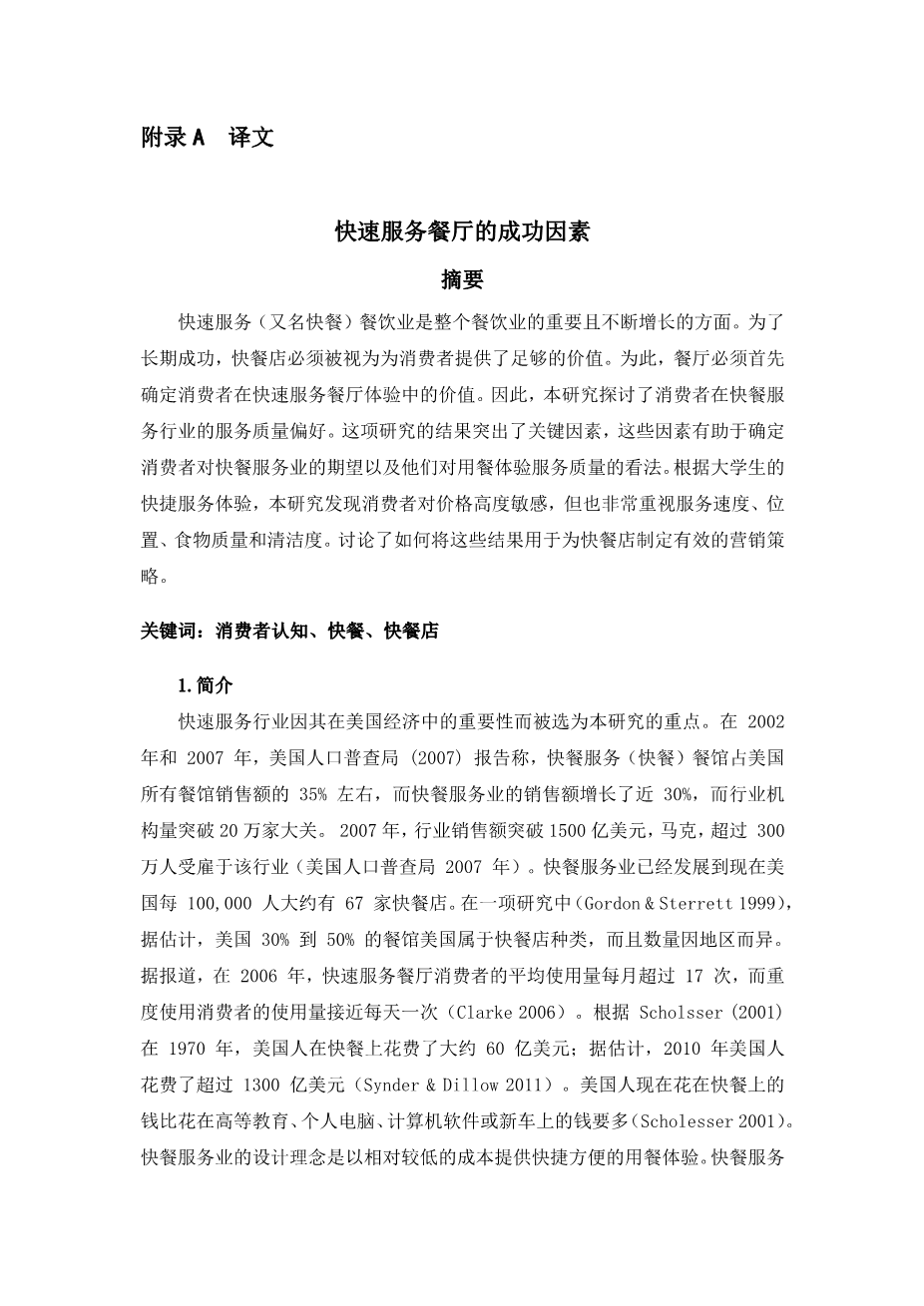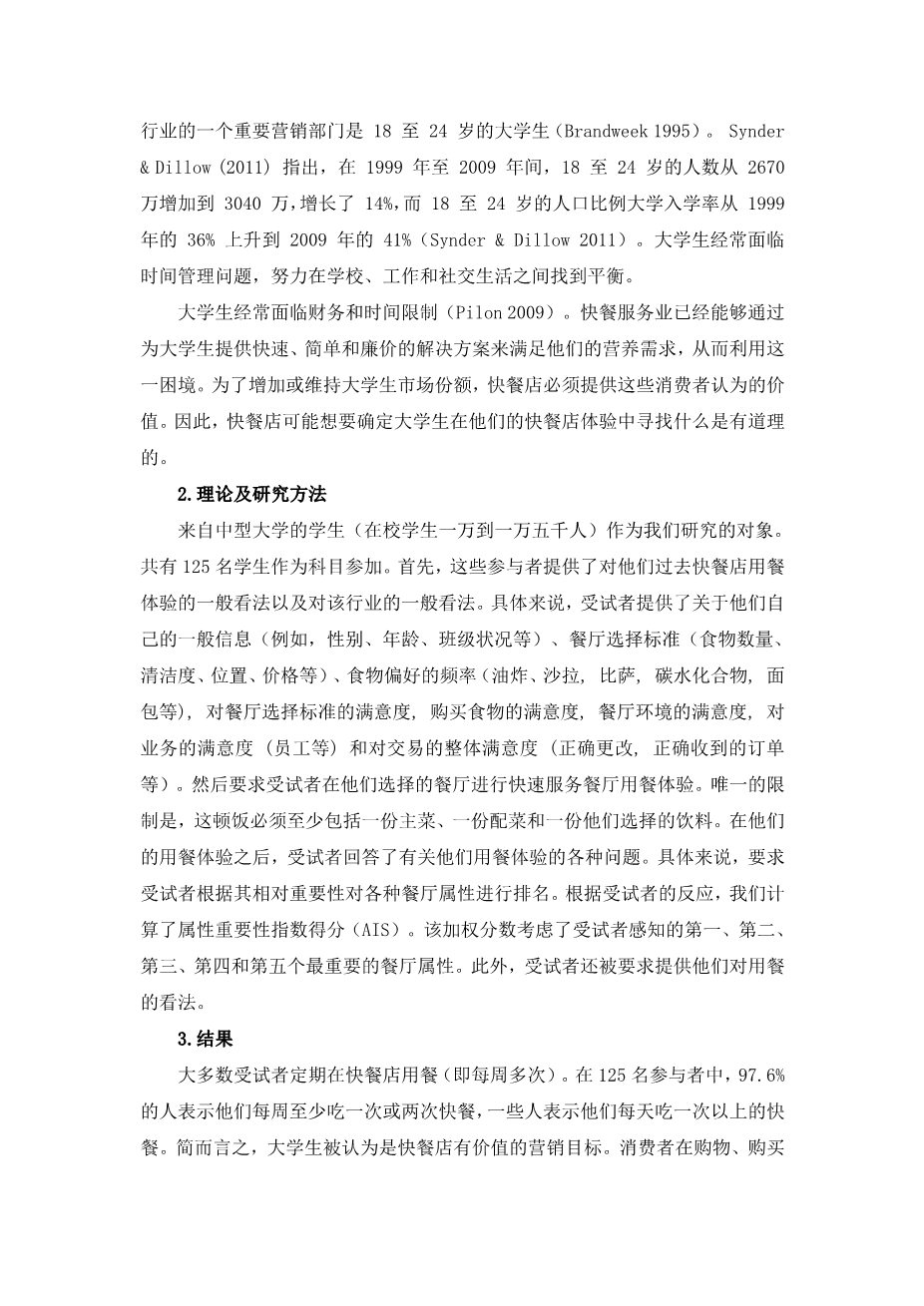快速服务餐厅的成功因素外文翻译资料
2023-04-12 19:20:23
Quick Service Restaurant Success Factors
Abstract:
The quick service (aka, fast food) restaurant industry is significant and growing aspect of the overall restaurant industry. For long-term success quick service restaurants must be perceived as offering sufficient value for consumers. To do this, restaurants must first determine what consumersrsquo; value in a quick service restaurant experience. As such, this research study explores consumersrsquo; service quality preferences in the quick service restaurant industry. Results of this research highlight critical factors which help to determine the expectations that consumers have about the quick service restaurant industry and their perceptions of service quality from a dining experience. Based upon university studentsrsquo; quick service experiences the results found in this study indicated that consumers are highly price sensitive, but also place high importance on speed of service, location, quality of food, and cleanliness. A discussion is provided for how these results can be used to develop effective marketing strategies for quick service restaurants.
Keywords:
Consumer Perceptions, Fast Food, Quick Service Restaurants
Introduction
The quick service industry was chosen as the focus of this research because of its significance in the American economy. In both 2002 and 2007, the U.S. Census Bureau (2007) reported that quick service (fast food) restaurants accounted for about 35% of all restaurant sales in the United States and that sales grew almost 30% for the quick service restaurant industry while the number of establishments for the industry surpassed the 200,000 mark. In 2007, the industryrsquo;s sales surpassed the $150 billion
mark, and more than three million people were employed in the industry (U.S. Census Bureau 2007). The quick service restaurant industry has grown to a point that there are now about 67 fast food restaurants for every 100,000 people in the U.S. In one study (Gordon amp; Sterrett 1999), it was estimated that between 30 and 50 percent of all restaurants in the U.S. were of the quick service restaurant variety and that the number varied regionally. Usage among average quick service restaurant consumers was reported in 2006 to be at over 17 visits per month and among heavy use consumers to be nearly one visit per day (Clarke 2006). According to Scholsser (2001) in 1970, Americans spent about six billion on fast food; in 2010, it is estimated that Americans spent more than $130 billion (Synder amp; Dillow 2011). Americans now spend more money on fast food than on higher education, personal computers, computer software, or new cars (Scholesser 2001). The quick service restaurant industry was designed around the concept of providing fast and convenience dining experiences at a relatively low cost. A significant marketing segment for the quick service restaurant industry is college age students, 18 to 24 years of age (Brandweek 1995). Synder amp; Dillow (2011) note that between 1999 and 2009, the number of 18- to 24-year-olds increased from 26.7 million to 30.4 million, an increase of 14 percent, and the percentage of 18- to 24-year-olds enrolled in college rose from 36 percent in 1999 to 41 percent in 2009 (Synder amp; Dillow 2011). College age students often face issues with time management, striving to find balance between school, work, and social life.
College age students often face financial and time constraints (Pilon 2009). The quick service restaurant industry has been able to capitalize on this dilemma by offering college students a quick, easy and inexpensive solution for their nutritional needs. To increase or maintain college student market share, quick service restaurants must offer value as perceived by these consumers. As such, it makes sense that quick service restaurants might want to determine what college students look for in their quick service restaurant experience.
Methods
Students from a mid-size university (enrollment of between ten and fifteen thousand students) served as subjects for our study. A total of 125 students participated as subjects. First, these participants provided general perceptions about their past quick service restaurant dining experiences and general perceptions about the industry. Specifically, subjects provided general information about themselves (e.g., gender, age, class status, etc.), restaurant selection criteria (quantity of food, cleanliness, location, price, etc.), frequency of food preferences (deep-fried, salads, pizza, carbohydrates, breads, etc.), satisfaction of restaurant selection criteria, satisfaction of the food purchased, satisfaction of the restaurant environment, satisfaction with the business (employees, etc.) and overall satisfaction with the transaction (correct change, correct order received, etc.). Then the subjects were asked to engage in a quick service restaurant dining experience at the restaurant of their choosing. The only restriction was that the meal must include at least one entreacute;e, one side item, and one beverage of their choosing. After their dining experience, subjects answered varying questions about their dining experience. Specifically, subjects were asked to rank various restaurant attributes according to their relative importance. From subjectsrsquo; responses we calculated an attribute importance index score (AIS). This weighted score takes into account the first, second, third, fourth, and fifth most important restaurant attributes as perceived by subjects. In addition, subjects were also asked to provide their perceptions about their dining experience.
Results
As shown in Table 1, the majority of the subjects dine at a quick service restaurant regularly (i.e., multiple times per week). Out of the 125 participants, 97.6% stated that they consume quick servi
剩余内容已隐藏,支付完成后下载完整资料


英语译文共 7 页,剩余内容已隐藏,支付完成后下载完整资料
资料编号:[589704],资料为PDF文档或Word文档,PDF文档可免费转换为Word




